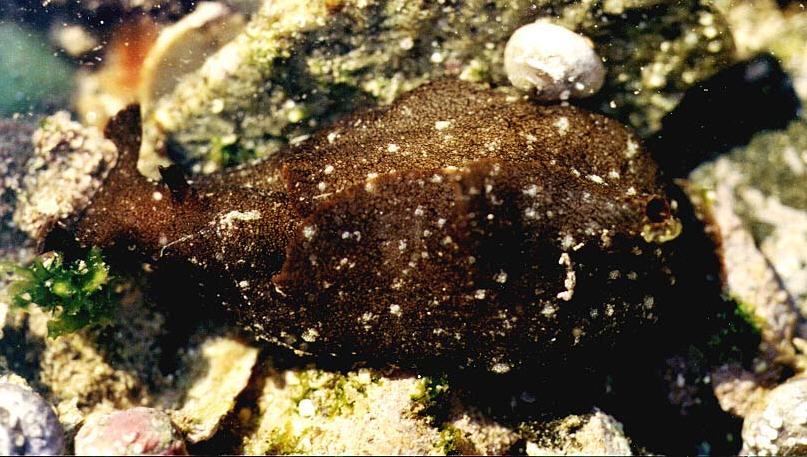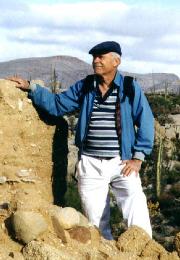 |
Aplysia cedrosensis
Photo courtesy of Dr. Wes Farmer
Aplysia cedrosensis Eales 1960.
Eales stated that : " the species (Aplysia vaccaria) has affinities with A. cedrosensis, but the latter has a thick, warted skin, brown mottled coloration, flat, non-tubular anal siphon, simple warts on the penis sheath lining, and shorted cusps to the lateral teeth of the radula."
For A. cedrosensis " The skin is tough and leathery, rough and carunculate, black and brown all over, but described as grey originally, with black patches and an elongated black band dorsally posterior to the rhinophores. Mantle and inner sides of the parapodia mottled and blotched irregularly. "Foot ," very broad with a tendency to form lateral wings, the edges defined, the tail short, broad, round, strongly contracted and bent ventral wards, so that it is difficult to determine whether it was sucker-like" My observations show that there is a posterior pedal sucker and have photographed the animal stretching from a ball shape to very elongate not unlike a hot-dog in shape only using its posterior pedal disk. The animal does this locomotion remarkably fast.
Aplysia cedrosensis has 19,000 teeth, 118(80.1.80). The shell is 76 mm by
57 mm. A 37 cm by 20 cm mollusk has a thin amber shell. Its 11,333 teeth
are 72(78.1.78). A small one has 2,900 teeth or 50(29.1.29). Its buccal
mass is very muscular for eating the prolific growing algae during the
growing season. It is a light sensitive sea hare and lives in rocky
habitats and where algae grows in abundance. Bahia de Los Angeles is where
most Aplysia cedrosensis were seen and photographed. One another occasion a
similar appearing animal was photographed from Cape Colnett. It was dark
brown and covered with nearly 50% large white/cream mottling. A
characteristic is that the animal is noticeably brown, not black and covered
with white specks or mottling. Darker lines help make up the color of the
brown or green or rust color skin. Another characteristic for A.
cedrosensis is the fast motion moving from a round ball shape being held in
place by the pedal disk and stretch outward into an elongate shape as an
inch worm stretches forward to grasp further up the branch. So does this
sea hare only fast. It will use the pedal disk to hang on and then stretch
out and attach the anterior area of the foot for a foot hold. Personally, I
have not observed A. vaccaria to be so agile in its mobility.
Errata
What brings to mind is the phenomena of look-a-like shell-less mollusks
(Western Society of Malacology Meeting in San Diego, and Asilomar) and how
people and researchers have grouped or lumped their observations. Their
work then published as one kind of species that in fact later proved to
included two or even three kinds of mollusks under that one Genus and
specie name. That kind of lumping still happens today to some degree.
Starting for example with one of my gross errors.
The mollusk reported in Notes on the Opisthobranchia of Baja California, Mexico, with Range Extensions - II The Veliger page 341 is a mistake. "The animal (see photo in aquarium) from Cape Colnett was 290 mm long when actively crawling. It was very dark reddish brown or nearly black with white speckled patches over the entire body except for the bluish blackish-brown foot. The tail was distinctly short and rounded. When disturbed the head and tail pulled into the body and virtually disappeared. The animal did not secrete a fluid when disturbed, but small white flecks of a fluid-like substance were give off. " (note: possibly mucus from the skin) "On 10 February 1964 it laid a large pinkish-white egg mass in my aquarium, about a month after having been caught." Actually the mollusk is an Aplysia cedrosensis and not as reported in 1964. What can I say, except I was trying to learn how to be and how to write field notes and scientist of opisthobranchology.
In Lance, 1967. Wesley Farmer brought to his attention an Aplysia vaccaria from Cape Colnett, he quoting Farmer, 1967. Lance along with Miss Joan E. Steinberg reports: "On April 12 and May 14, 1964, Miss Joan El Steinberg and I observed Aplysia vaccaria to be an abundant inhabitant of the rocky intertidal regions at Bahia de Los Angeles in the northern part of the Gulf of California." Indeed their observation might be those of Aplysia cedrosensis that is rather abundant in the region.
Keen 1971 reports for Aplysia vaccaria Winkler, 1955. As occurring in Bahia de Los Angeles, Gulf of California. However with animals that look-a-like it is possible the two mollusks were lumped together. That is to include Aplysia cedrosensis as Aplysia vaccaria.
Aplysia cedrosensis Eales 1960. The original described is from the Pacific coast at Cedros Island and Turtle Bay, Baja California Sur. It is an animal not unlike Aplysia vaccaria Winkler in size and weight. Aside from that there are some marked differences.
When one works only with preserved material and not live these kinds of
comments appear in the Literature for: "Aplysia cedrosensis and A. vaccaria
seem more closely related to each other than either of them is to A.
reticulopoda." They also say that Aplysia cedrosensis is not a California
species and "It must be remembered that this represents study on only a few
preserved specimens. Study must be made of large series of the fresh
animals before really definitive and quantitative criteria can be
established."
Summary
From my perspective A. cedrosensis is distinctive. Young mollusks may be
of one uniform color light or dark brown or green or rust skin color. Large
mollusks may be light or dark brown with many small or large cream color
mottling over most of its body. The sole of the foot is brown or may be
almost black in large animals. Their range apparently is less abundant in
California. More field work in fact needs to be made with A. cedrosensis in
mind. Why not a close look at the DNA? The DNA from the critters from
Bahia de Los Angels in the Gulf and from Cedros Island area.
There my be very fine dark lines in the skin along with white or cream mottling
in most of the skin except the sole of the foot.
The young animals my not have any spots dark or light in their skin. In
fact may range in color from dark green to predominate rusty red in color
and some brown. To show some of this variation the photo on one A.
cedrosensis is very dark with light mottling. Another is light brown with
white-cream mottling. They are noticeable swift in their locomotion.
Literature cited:
Beeman, Robert D. 1960. A NEW TECTIBRANCH, Aplysia reticulopoda, FROM THE
SOUTHERN CALIFORNIA COAST. Bulletin, So. Calif. Academy of Sciences Vol.59,
part 3. Pages 144-152. 1 Table, 3 plates. (Note: It appears that
reticulapoda, vaccaria and cedrosensis are all firm like a cantaloupe when
living.)
Eales, N. B., D.Sc. 1960. REVISION OF THE WORLD SPECIES OF APLYSIA
(GASTROPODA, OPISTHOBRANCHIA) Vol. 5 No; 10 pages 354-360 for A.
cedrosensis. And pages 371-377 for A. vaccaria. (Note: most useful with
characteristics, however reports Cedros Island as being in the Gulf of
California)
Farmer, Wesley M. 1967. Notes on the Opisthobranchia of Baja California,
Mexico, with range extensions - II. The Viler 9(3):340-342; 1 text fig. (1
January 1967). (Note: A. cedrosensis miss identified as A. vaccaria)
Farmer, Wesley M. 1987. Nudibranch-Look-A-Likes, a presentation to 20th
Annual Meeting Western Society of Malacologists. A comparison of external
characteristics of some species of Acanthodoris Hypselodoris, Chromodoris,
Tambjaand Roboastra and illustrations for seeing differences. (Note: this
presentation demonstrated the difficulty researchers have is seeing the
difference and reporting correctly.)(Note: Because of a human trait to
lump, it raises some questions as to variations in field identifications
for published lists of some species.)
Farmer, Wesley M. 1990. Tidepool Wonders of the Sea of Cortez III (a field
guide). 86 pages. (Note: Three species are compared: Aplysia
californiensis, vaccaria and cedrosensis)
Farmer, Wesley M., 1992. Three Aplysias of the Californiaís A. californica,
A. cedrosensis and A. vaccaria. Presented: 1992 Western Society of
Malacologists convention at Asilomar.
Gerhard, Peter and Howard E. Gulick, 1962 Third edition. Lower California
Guidebook. 243 pages(Note: MAP 16 fold out does not show a Cedros Island in
the Gulf of California. However does show one West of Scammonís Lagoon and
north of Turtle Bay.)
Keen, A. Myra, 1971. Sea Shells of Tropical West America Marine Mollusks
from Baja California to Peru. 1064 pages, Illustrations and plates. (Note:
2295 Aplysia (Aplysia) vaccaria from Bahia de Los Angeles, Gulf of
California. May actually be an Aplysia cedrosensis that is so abundant in
the area. A. cedrosensis is not listed.)

| Wesley enjoys nature in the great out of doors. It is fun discovering
something new or different for a better understanding of science. The
Webmaster is indebted to Wes for taking the time to put together this BOW
on such short notice. Wes still has few copies of SEA-SLUG GASTROPODS
available. The book has 157 species of sea slugs occurring from Panama to
Alaska. The book was published in 1980. The book normally sells for $10.00.
Should you like a floppy with the book that includes 60 Microsoft
PowerPoint line drawing images in color and black and white then make that
price $17.50 plus postage and handling.
Send Wes email at wmfarmer@adnc.com |
